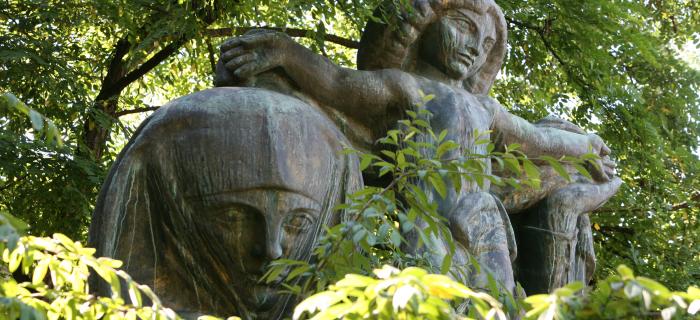DÉCOUVREZ LES 14 MUSÉES DE LA VILLE DE PARIS
Main menu

The garden overlooking the street
The garden contains Bourdelle's most famous bronze statues, cast from the models displayed in the Great Hall.
The Four figures of the Monument au général Alvéar (Monument to general Alvear) (1913-1923) - La Liberté (Liberty), La Force (Strenght), La Victoire (Victory) and l'Eloquence (Eloquence) - stand proudly in front of the arcade of the brick peristyle. Driven out of Eden, Adam (1889) now stands between Pénélope (Penelope) (1905-1912), an unshakeable pillar of fidelity, and Les Fruits ou la nudité des fruits (Fruit or the nudity of Fruit) (1902-1906), a chaste, voluptuous Eve crowned with apples...The sensuality of the Baigneuse accroupie (Crouching bather) (1906-1907) still bears the mark of Rodin. Standing out among these works, the "bravura piece" of Héraklès archer (Hercules the Archer) (1910) emerges as a sign of virile energy and the triumph of the artist.
The inner garden
In the familiar maze of the studios, their inner garden forms a heaven of peace. There is no better place for contemplation than this shady grove, covered in ivy. Beneath the gnarled locust trees, Bourdelle's bronze sculptures enlighten the architecture with their presence. Their patina echoes the grey-green colour of the tree trunks. La Vierge à l'offrande (The Virgin of the Offering) (1919-1923) "seems half-aware of the divine weight she bears." (Bourdelle).
The Centaure mourant (Dying Centaur) (1911-1914) drifts off into a dream, a meditation shared by the poetess Sapho (Sapho) (1889-1925), on her solitary rock.
"... You hid, children at the foot of the dark laurel tree,
Concealed beneath its great cloak of shade,
When I passed by, yesterday, on my way to the city.
And I saw you, I saw your beauty,
Like wine for the eyes, I drank it in long draughts."
(Sapho of Lesbos, 7th and 8th century B.C. Translation by Marguerite Yourcenar)